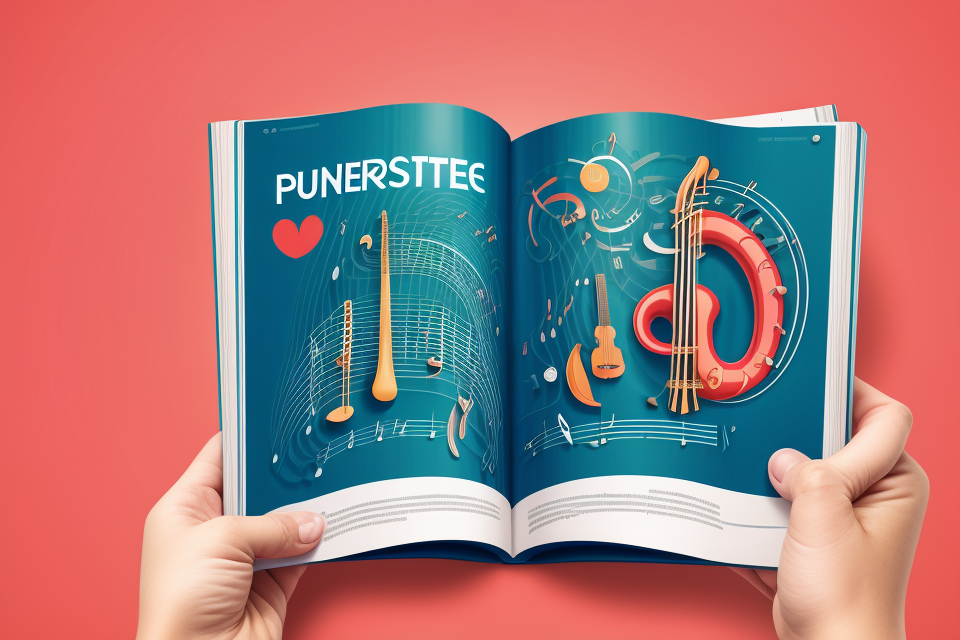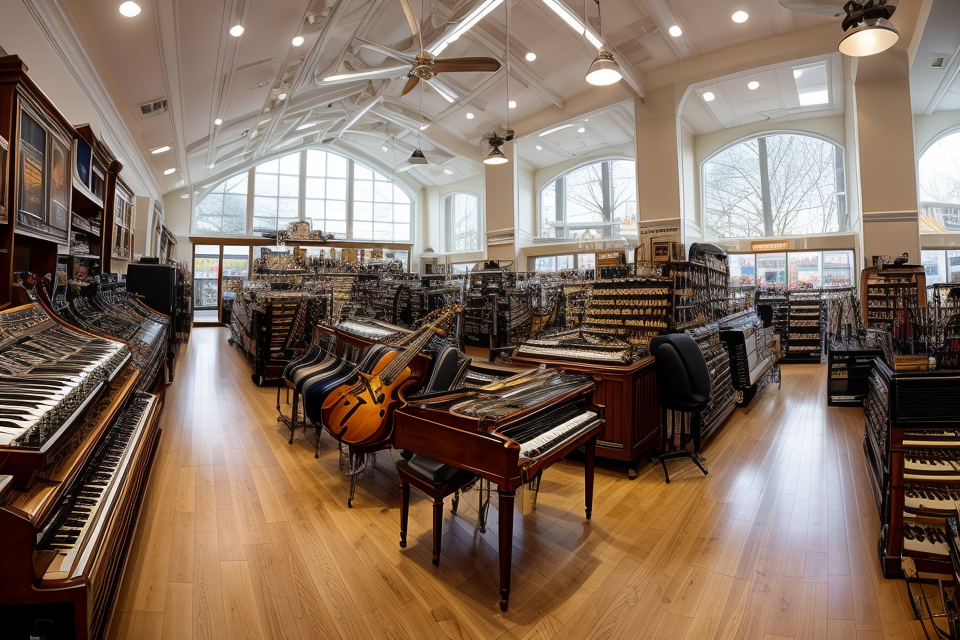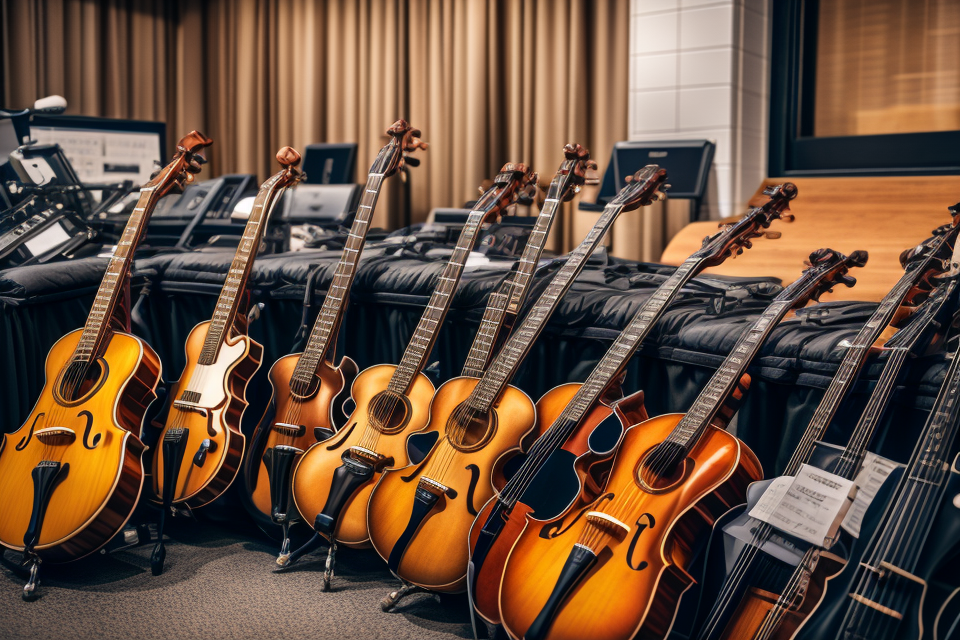Choosing the right instrument can be a daunting task, especially if you’re a beginner. With so many options available, it can be overwhelming to decide which one is the best fit for your needs. But don’t worry, we’ve got you covered! In this comprehensive guide, we’ll walk you through the process of selecting the perfect instrument for your musical journey. Whether you’re a budding musician or a seasoned pro, this guide will help you make an informed decision that will enhance your musical experience. So, let’s get started and explore the world of instruments!
Factors to Consider When Choosing an Instrument
Your Musical Interests and Goals
Exploring Different Genres and Styles
When choosing an instrument, it’s essential to consider your musical interests and goals. One way to do this is by exploring different genres and styles of music. For example, if you’re interested in rock music, you might want to consider learning the guitar or bass. If you’re interested in jazz, you might want to consider learning the saxophone or trumpet.
By exploring different genres and styles of music, you can gain a better understanding of the instruments commonly used in each style. This can help you make an informed decision about which instrument is right for you.
Setting Short-Term and Long-Term Goals
Another important factor to consider when choosing an instrument is your musical goals. Do you want to play for fun and enjoyment, or do you want to pursue a career in music? Setting short-term and long-term goals can help you determine the best instrument for your needs.
If you’re looking to play for fun and enjoyment, you might not need to invest in a high-end instrument. However, if you’re pursuing a career in music, you’ll want to invest in a high-quality instrument that will help you achieve your goals.
It’s also important to consider your short-term and long-term goals when it comes to the type of music you want to play. For example, if you want to play in a rock band, you might want to focus on learning the guitar or bass. If you want to play in an orchestra, you might want to focus on learning the violin or cello.
Overall, setting short-term and long-term goals can help you choose the right instrument for your needs. By considering your musical interests and goals, you can make an informed decision that will help you achieve your dreams.
Your Physical Abilities and Comfort
Physical Features of Instruments
When choosing an instrument, it is important to consider the physical features of the instrument. This includes the size, weight, and design of the instrument. For example, a larger instrument may be more difficult to hold and play for extended periods of time, while a smaller instrument may be more portable but may lack the same range of sound. Additionally, some instruments may have more intricate designs that can make them more difficult to play, while others may have simpler designs that are easier to handle.
Playing Techniques and Skills
Another important factor to consider when choosing an instrument is your own physical abilities and comfort. This includes your dexterity, hand-eye coordination, and overall physical strength. For example, playing a stringed instrument such as the violin or guitar requires the use of fingers to press down on the strings, which can be difficult for those with limited finger dexterity. Additionally, some instruments may require the use of arm or shoulder strength, which can be challenging for those with physical limitations.
It is also important to consider your own personal comfort when playing an instrument. This includes the position of the instrument, the pressure of the instrument against your body, and the overall posture required to play the instrument. For example, playing the trumpet requires the use of the lips and embouchure, which can be uncomfortable for some people. Additionally, some instruments may require a certain posture or stance that can be physically demanding over time.
When considering these physical factors, it is important to consult with a music teacher or professional musician who can provide guidance on the best instrument for your individual needs and abilities. They can help you find an instrument that is comfortable to play and suits your physical limitations, while also providing guidance on how to improve your physical abilities over time.
Your Budget and Financial Constraints
When choosing an instrument, it’s important to consider your budget and financial constraints. The cost of the instrument itself is just the beginning. You’ll also need to factor in the cost of accessories and maintenance expenses.
Cost of Instruments
The cost of an instrument can vary widely depending on the type of instrument and its quality. For example, a beginner-level acoustic guitar may cost anywhere from $100 to $500, while a high-end electric guitar can cost upwards of $2,000. It’s important to set a budget for yourself and stick to it, so you don’t end up overspending.
Accessories and Maintenance Costs
In addition to the cost of the instrument itself, you’ll also need to budget for accessories and maintenance expenses. For example, if you choose a guitar, you’ll need to purchase strings, a guitar pick, and a tuner. You may also need to purchase music books or online lessons to help you learn how to play. Over time, you’ll also need to have your instrument serviced and maintained by a professional, which can add up in costs. It’s important to factor these expenses into your budget when choosing an instrument.
Researching and Comparing Instruments
Identifying Reputable Brands and Models
Online Resources and Reviews
When researching instruments, online resources and reviews can be a valuable tool for identifying reputable brands and models. There are numerous websites that provide comprehensive reviews of various instruments, allowing you to compare different models and read about the experiences of other musicians. Websites such as Musician’s Friend, Sweetwater, and Amazon offer user reviews and ratings for a wide range of instruments, helping you to make an informed decision based on the experiences of others.
Consulting with Musicians and Experts
In addition to online resources, consulting with musicians and experts can also be helpful when identifying reputable brands and models. Reaching out to other musicians who have experience with different instruments can provide valuable insights and recommendations based on personal experience. Additionally, consulting with music teachers or professionals at music stores can provide additional guidance and help you to identify the best instrument for your needs and skill level.
Evaluating the Quality and Features of Instruments
Sound Quality and Tone
When evaluating the quality and features of instruments, it is important to consider the sound quality and tone. The sound quality refers to the overall clarity and richness of the instrument’s sound, while the tone refers to the unique character and timbre of the instrument’s sound. Different instruments have different tonal qualities, and it is important to choose an instrument that produces a sound that meets your needs and preferences.
To evaluate the sound quality and tone of an instrument, you can listen to recordings of the instrument being played, or you can try playing the instrument yourself to get a sense of its sound. It is also helpful to consider the intended use of the instrument, as certain instruments may be better suited for certain types of music or playing styles.
Materials and Construction
Another important factor to consider when evaluating the quality and features of instruments is the materials and construction. The materials used to make the instrument can affect its sound quality, durability, and overall performance. Different instruments are made from different materials, and it is important to choose an instrument that is made from materials that are suitable for your needs and preferences.
For example, wood is a common material used in the construction of stringed instruments such as violins and cellos, while brass and wood are used in the construction of wind instruments such as trumpets and trombones. The quality of the materials used can also affect the instrument’s longevity and resistance to wear and tear.
Features and Customization Options
Finally, it is important to consider the features and customization options of an instrument when evaluating its quality and features. Different instruments have different features and customization options, and it is important to choose an instrument that has the features and customization options that meet your needs and preferences.
For example, some instruments may have adjustable mechanisms that allow for fine-tuning of the instrument’s sound, while others may have additional accessories such as stands or cases. Some instruments may also be customizable in terms of their appearance, such as the color or design of a guitar or the engraving on a brass instrument.
In conclusion, when evaluating the quality and features of instruments, it is important to consider the sound quality and tone, materials and construction, and features and customization options. By carefully considering these factors, you can choose an instrument that meets your needs and preferences and helps you achieve your musical goals.
Assessing Your Needs and Priorities
When choosing an instrument, it is essential to assess your needs and priorities. This section will provide you with some key factors to consider when determining what instrument is right for you.
Balancing Cost and Quality
One of the primary considerations when choosing an instrument is the balance between cost and quality. It is important to determine what you can afford and what you are willing to spend, but it is also essential to remember that a higher-quality instrument may provide better performance and longevity. When evaluating the cost of an instrument, consider the cost of maintenance, accessories, and any additional expenses associated with playing the instrument.
Making Informed Decisions
Making an informed decision when choosing an instrument is crucial. This means researching different instruments, reading reviews, and seeking advice from professionals. Take the time to visit music stores and try out different instruments to determine which one feels and sounds right for you. It is also important to consider the type of music you want to play and the style of playing that best suits your preferences.
In addition to the cost and quality of the instrument, other factors to consider include the size and weight of the instrument, the materials used to make it, and the accessories that come with it. For example, if you plan to travel frequently with your instrument, you may want to consider a lighter model. If you have small hands, you may want to choose an instrument with a smaller size.
When assessing your needs and priorities, it is also important to consider your goals as a musician. If you are a beginner, you may want to choose an instrument that is easier to play and less expensive. If you are a professional musician, you may want to invest in a higher-quality instrument that will provide better performance and longevity.
Overall, assessing your needs and priorities is a crucial step in choosing the right instrument for your needs. By considering factors such as cost, quality, size, weight, materials, accessories, and your goals as a musician, you can make an informed decision that will provide you with the best possible experience playing your chosen instrument.
Purchasing and Acquiring Your Instrument
Finding Reputable Dealers and Retailers
Online Marketplaces and Retailers
When searching for a reputable dealer or retailer for your instrument, online marketplaces and retailers are a convenient option. Websites such as Amazon, eBay, and Reverb are popular choices for musicians looking to purchase instruments. These platforms offer a wide range of options from various sellers, allowing you to compare prices and read reviews before making a purchase. However, it’s important to be cautious when purchasing from online marketplaces, as not all sellers are created equal. Be sure to read reviews and research the seller before making a purchase to ensure that you’re getting a quality instrument from a reputable source.
Local Music Stores and Shops
In addition to online marketplaces, local music stores and shops can also be a great resource for finding reputable dealers and retailers. These stores often have knowledgeable staff who can assist you in finding the right instrument for your needs, and they may also offer services such as repairs and maintenance. Additionally, by supporting local businesses, you can help keep music education and music-making accessible in your community.
When shopping at local music stores, it’s important to do your research ahead of time to ensure that you’re dealing with a reputable dealer. Look for reviews online and ask other musicians for recommendations. It’s also a good idea to ask the staff questions about the instruments they carry and their knowledge of the products. By taking the time to find a reputable dealer or retailer, you can ensure that you’re getting a quality instrument that will meet your needs and last for years to come.
Evaluating and Testing Instruments Before Purchase
Evaluating and testing instruments before purchase is an essential step in ensuring that you select the right instrument for your needs. This process involves assessing the instrument’s quality, sound, and overall performance to ensure that it meets your requirements. Here are some methods to consider when evaluating and testing instruments before purchase:
In-Store Demonstrations and Trials
One of the best ways to evaluate an instrument’s quality and sound is by participating in an in-store demonstration or trial. Many music stores offer the opportunity to try out instruments before purchasing them. This allows you to test the instrument’s playability, sound quality, and overall performance. Additionally, you can also ask the store’s staff for their professional opinion on the instrument’s quality and suitability for your needs.
Renting and Testing Instruments
Renting an instrument is another option to consider when evaluating and testing instruments before purchase. Many music stores offer rental programs that allow you to try out an instrument for a set period of time. This can be a great way to test the instrument’s quality and performance before committing to a purchase. Additionally, rental programs often include maintenance and repair services, which can be beneficial in ensuring the instrument remains in good condition throughout the rental period.
In conclusion, evaluating and testing instruments before purchase is a crucial step in selecting the right instrument for your needs. In-store demonstrations and trials, as well as rental programs, are excellent methods to assess an instrument’s quality, sound, and overall performance. By taking the time to evaluate and test instruments, you can ensure that you select the right instrument for your musical endeavors.
Finalizing Your Purchase and Setting Up Your Instrument
Understanding Warranties and Returns
Before finalizing your purchase, it is important to understand the warranty and return policy offered by the seller. This information can typically be found on the seller’s website or by contacting their customer service department. It is important to note that some warranties may not cover certain types of damage or wear and tear, so be sure to read the fine print carefully. Additionally, some sellers may have different return policies for different types of instruments, so be sure to ask about the specific policy for the instrument you are interested in purchasing.
Adjusting and Setting Up Your Instrument
Once you have finalized your purchase, it is important to properly adjust and set up your instrument. This may involve tuning the instrument, adjusting the strings or keys, or making any necessary repairs. It is recommended to consult with a professional musician or technician to ensure that your instrument is properly set up and ready to play. Additionally, be sure to follow any manufacturer recommendations or guidelines for setting up and adjusting your instrument.
In conclusion, finalizing your purchase and setting up your instrument is an important step in ensuring that you get the most out of your new instrument. By understanding the warranty and return policy, and properly adjusting and setting up your instrument, you can ensure that it is ready to play and meets your needs.
Beginning Your Musical Journey
Practicing and Learning Techniques
- Developing Good Habits: Start by setting aside a dedicated time and space for practicing your instrument. It’s important to create a routine and stick to it, even if it’s just for a few minutes each day. Consistency is key when it comes to learning an instrument.
- Building Technique: As you begin your musical journey, it’s important to focus on building a strong foundation of technique. This includes developing good posture, correct fingerings, and proper breathing techniques, depending on the instrument you choose. Practice scales and exercises designed to strengthen your muscles and improve your dexterity.
- Seeking Feedback: Don’t be afraid to ask for feedback from more experienced musicians or music teachers. They can help you identify areas where you need to improve and provide guidance on how to achieve your goals.
Joining Music Communities and Networks
- Finding Resources: There are many resources available to help you on your musical journey. Joining music communities and networks can provide you with access to tutorials, sheet music, and other resources that can help you improve your skills.
- Meeting Other Musicians: Joining music communities and networks can also help you connect with other musicians who share your interests. This can be a great way to find collaborators, get feedback on your playing, and simply share your passion for music with others.
- Performing Opportunities: Many music communities and networks also provide opportunities for musicians to perform and share their music with others. This can be a great way to gain experience and build your confidence as a musician.
Performing and Sharing Your Music
- Showcasing Your Talent: Performing your music is a great way to showcase your talent and connect with others who share your passion for music. Look for opportunities to perform at local venues, open mic nights, or other events where you can share your music with others.
- Building Your Audience: As you begin to perform more frequently, you’ll start to build an audience of people who appreciate your music. Use social media and other online platforms to connect with your audience and share updates about your music.
- Collaborating with Other Musicians: Collaborating with other musicians can be a great way to learn new techniques, explore different styles of music, and simply have fun making music with others. Look for opportunities to collaborate with other musicians in your community or online.
FAQs
1. What factors should I consider when choosing an instrument?
When choosing an instrument, it’s important to consider several factors such as your personal preferences, the type of music you want to play, your skill level, and the size and weight of the instrument. Additionally, you should also consider the cost, the maintenance requirements, and the availability of accessories and replacement parts.
2. How do I know what type of instrument is right for me?
The type of instrument you choose will depend on your personal preferences and the type of music you want to play. For example, if you want to play classical music, a violin or a cello may be the best choice. If you want to play rock or pop music, a guitar or a drum set may be more suitable. It’s important to try out different instruments to find the one that feels most comfortable and suits your playing style.
3. What is the best way to learn about different instruments?
The best way to learn about different instruments is to do research online, read reviews, and watch videos demonstrating the different types of instruments. You can also visit music stores and ask the staff for advice and recommendations. Additionally, you can also talk to other musicians and ask for their recommendations based on their own experiences.
4. How much should I expect to spend on an instrument?
The cost of an instrument can vary widely depending on the type of instrument, the brand, and the quality. Generally, you can expect to spend anywhere from a few hundred dollars to several thousand dollars on a good quality instrument. It’s important to keep in mind that a higher-priced instrument may have better sound quality, better construction, and be more durable.
5. How do I know if an instrument is of good quality?
When evaluating the quality of an instrument, it’s important to consider the materials used, the craftsmanship, and the sound quality. A well-made instrument should have a good finish, be free of cracks or damage, and have a good action. Additionally, you should also listen to the instrument being played and pay attention to the sound quality. A good quality instrument should produce a clear, rich, and well-balanced sound.



